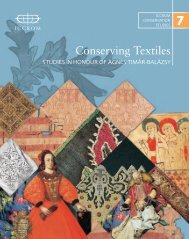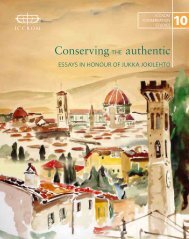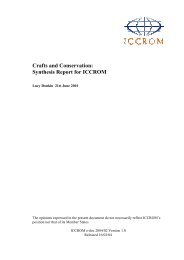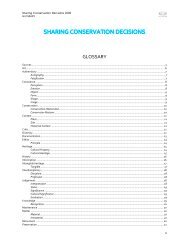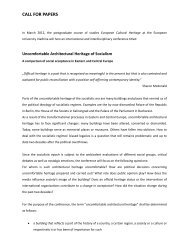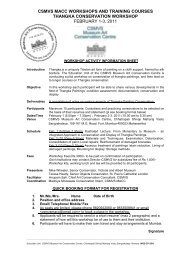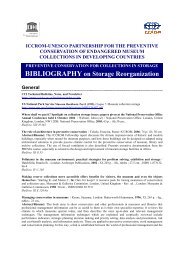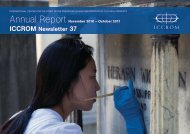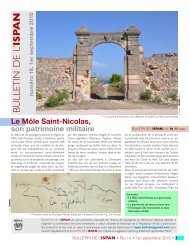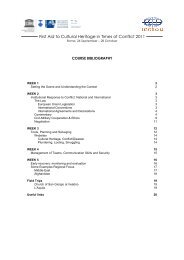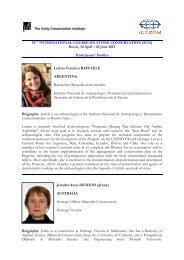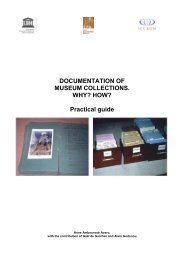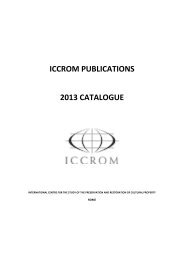part 1 - Iccrom
part 1 - Iccrom
part 1 - Iccrom
Create successful ePaper yourself
Turn your PDF publications into a flip-book with our unique Google optimized e-Paper software.
MEASURING HERITAGE CONSERVATION PERFORMANCE<br />
6th International Seminar on Urban Conservation<br />
Figure 3. An Indian in the lake, Burle Marx design (Burle<br />
Marx, 1987).<br />
4. Indicators of conservation<br />
of Burle Marx gardens<br />
The restoration in 2004 of Praça Euclides da Cunha<br />
in Recife, a garden that was designed by Roberto<br />
Burle Marx in 1935, represented a landmark in the<br />
debate on the conservation of historic gardens.<br />
Gradually, awareness about the need to preserve<br />
this special type of monument is growing but there<br />
are still great difficulties, beginning with ignorance<br />
by technicians and gardeners about the complexity<br />
of a garden/artwork and need for training by those<br />
responsible for its maintenance.<br />
The garden restoration experience was led by the<br />
Municipality of Recife and by the Landscape Laboratory<br />
at the Federal University of Pernambuco. It<br />
was nationally recognized because it was in Recife<br />
that Burle Marx established his career as a landscape<br />
designer. The inventory of Burle Marx gardens in<br />
Recife was completed in May 2009 and prompted<br />
the discussion between researchers and technicians<br />
with the purpose of recording the valuation of a garden<br />
monument. The heritage values of the gardens<br />
recognized so far are set out, with a view towards<br />
formulating indicators of conservation. In fact these<br />
contain overlapping values, but are directly relevant<br />
considerations for the content of each indicator.<br />
The historical value is understood from steps that<br />
stood out in the course of evolution of a <strong>part</strong>icular<br />
aspect of human activity. It represents something<br />
that is so essential and vital in the evolutionary<br />
chain that it has conditioned what occurred later.<br />
The change of elements of the original design of<br />
some of the Burle Marx gardens is now much more<br />
evident. For example, the sculpture of an Indian in<br />
Praça de Casa Forte (Figure 3) was placed in the<br />
central lake of Amazonian plants and the sculpture<br />
Figure 4. The sculpture of a man from Sertão region in Praça<br />
Euclides da Cunha, 2008.<br />
of a civilized Indian was placed in the centre of cacti<br />
from Praça Euclides da Cunha (Figure 4).<br />
The presence of high-density construction – housing,<br />
commerce and services – in the area surrounding<br />
Praça de Casa Forte induced a new aspect to the<br />
indicator: permanence of constructive typology of<br />
the time of garden construction. From the identification<br />
of species, it is seen that 42% of total species<br />
in the garden today are from the original design of<br />
Praça de Casa Forte. Another indicator then is: presence<br />
of vegetation from the original project.<br />
With regard to historical buildings, in Praça de Casa<br />
Forte and Praça da República various types were<br />
identified. This generated the indicator: presence of<br />
historic buildings or monuments in the square and<br />
in the surrounding area. Legally there is an instrument<br />
protecting special areas of Historic Preservation<br />
such as the old houses of Praça de Casa Forte,<br />
but this makes no mention to the garden. Another<br />
indicator was therefore generated: effectiveness of<br />
implementation of the standard of protection.<br />
Signs for the gardens would demonstrate heritage<br />
education level, but the absence of these in<br />
relation to Burle Marx gardens in surrounding and<br />
other locations of the city was noted. This prompts<br />
development of the following indicator: existence of<br />
signage for historic gardens to Centre-suburb and<br />
signposts in surroundings and within the garden.<br />
A tour is another item of extreme importance<br />
that informs residents and discloses the attractive<br />
aspects of the place. There isn’t an official tour that<br />
provides residents and tourists with the knowledge<br />
of this historical legacy. This indicator is: inclusion<br />
in the tourist circuit as <strong>part</strong> of the city history.<br />
The architectural value refers to the types of construction<br />
and the materials of the components that<br />
Carneiro, A. R. S.; da Silva, J. M.; Veras, L. M. de S. & A. de F. Silva. 2012. The complexity of historic garden life conservation.<br />
In Zancheti, S. M. & K. Similä, eds. Measuring heritage conservation performance, pp. 33-41. Rome, ICCROM.<br />
38



